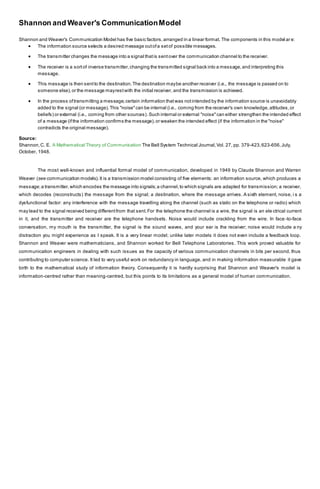
Mass com
- 1. Shannon and Weaver's CommunicationModel Shannon and Weaver's Communication Model has five basic factors,arranged in a linear format. The components in this model ar e: The information source selects a desired message outofa setof possible messages. The transmitter changes the message into a signal thatis sentover the communication channel to the receiver. The receiver is a sortof inverse transmitter,changing the transmitted signal back into a message,and interpreting this message. This message is then sentto the destination.The destination maybe another receiver (i.e., the message is passed on to someone else),or the message mayrestwith the initial receiver, and the transmission is achieved. In the process oftransmitting a message,certain information thatwas notintended by the information source is unavoidably added to the signal (or message).This "noise"can be internal (i.e., coming from the receiver's own knowledge,attitudes,or beliefs) or external (i.e., coming from other sources).Such internal or external "noise"can either strengthen the intended effect of a message (ifthe information confirms the message),or weaken the intended effect (if the information in the "noise" contradicts the original message). Source: Shannon,C. E. A Mathematical Theory of Communication The Bell System Technical Journal,Vol. 27, pp. 379-423,623-656,July, October, 1948. The most well-known and influential formal model of communication, developed in 1949 by Claude Shannon and Warren Weaver (see communication models).It is a transmission model consisting of five elements: an information source, which produces a message;a transmitter,which encodes the message into signals;a channel,to which signals are adapted for transmission; a receiver, which decodes (reconstructs) the message from the signal; a destination, where the message arrives. A sixth element, noise, i s a dysfunctional factor: any interference with the message travelling along the channel (such as static on the telephone or radio) which may lead to the signal received being differentfrom that sent.For the telephone the channel is a wire, the signal is an ele ctrical current in it, and the transmitter and receiver are the telephone handsets. Noise would include crackling from the wire. In face -to-face conversation, my mouth is the transmitter, the signal is the sound waves, and your ear is the receiver; noise would include a ny distraction you might experience as I speak. It is a very linear model; unlike later models it does not even include a feedback loop. Shannon and Weaver were mathematicians, and Shannon worked for Bell Telephone Laboratories. This work proved valuable for communication engineers in dealing with such issues as the capacity of various communication channels in bits per second, thus contributing to computer science. It led to very useful work on redundancy in language, and in making information measurable it gave birth to the mathematical study of information theory. Consequently it is hardly surprising that Shannon and Weaver's model is information-centred rather than meaning-centred, but this points to its limitations as a general model of human communication.
